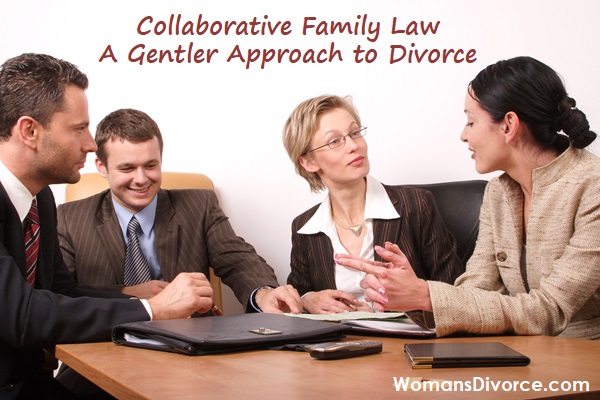- Home
- Divorce Basics
- Collaborative Divorce Alternatives
Collaborative Divorce Alternatives vs. Litigation
Basically, a divorce is either contested (the parties disagree on certain issues) or uncontested (the parties are able to reach a mutual agreement on all the issues). A contested divorce is an adversarial process waged in the courtroom where a judge makes the final decision on how everything is handled. In an uncontested divorce, the couple is able to reach an agreement using collaborative divorce alternatives without having to fight it out in court.
To help you understand the principles of this approach, you need to understand what collaboration means. Collaboration is the process of working together towards a common goal. In the case of a divorce, it means working out the issues of your divorce settlement in a non-confrontation manner so the matter is settled out of the courtroom.
Some of the main reasons to consider reaching a mutual agreement include:
- Time - There are numerous steps to a contested divorce, including discovery, pre-trial hearings, settlement proposals, and much more. A contested divorce can take months to a year or more. When both sides mutually agree how to settle everything, an uncontested divorce can be filed and approved by the court in a much quicker time-frame.
- Cost - A contested divorce can cost thousands, even tens of thousands of dollars, depending on where you live and how many issues will need to be decided by the judge. Spouses have to pay for their lawyers, expert testimony, forensic investigations, custody evaluators, etc. In comparison, an uncontested divorce is a much cheaper option.
- Privacy - If your divorce war is waged in the courtroom, what is discussed during divorce litigation becomes part of the divorce trial record. On the other hand, private negotiations for an uncontested divorce don't become part of your official divorce record.
- Relationship between spouses - There is usually a lot of animosity between spouses who go to court for their divorce. This may not be an issue for couples who don't have children together. But for those that do, being able to cooperate and do what's best for their children after a divorce trial can be difficult. Getting an uncontested divorce makes it easier to stay on friendly grounds with your ex so you can continue to co-parent after the divorce.
Alternatives to a litigated divorce
The are different ways to reach a divorce settlement without having to wage a court battle over who gets what. Some of the main alternatives to traditional litigated divorce include:
1. Direct Negotiations
This is the quickest and least expensive way to negotiate your divorce settlement. With direct negotiations, the divorcing couple work together to reach a mutual agreement on their divorce settlement, whether it's at the lawyer's office or around the kitchen table. Once everything is settled, the divorce paperwork can be completed by a lawyer, paralegal, or by the spouses themselves with the help of an online divorce service.
2. Divorce mediation
In mediation, the couple meets with a mediator who helps them work through the issues that need to be settled. The mediator doesn't advocate for either side and strives to remain neutral in the negotiations. Once all the issues are settled, the mediator drafts the marital settlement agreement, which can be incorporated into the final divorce agreement.
Each client should consult with their own attorney before signing the final divorce agreement. Find out more about using mediation in divorce.
3. Collaborative divorce
Collaborative divorce is similar to mediation in that the couple peacefully negotiate their divorce agreement outside the courtroom. In a collaborative divorce, each spouse is represented by a lawyer who is trained in the collaborative divorce process. Both lawyers and their spouses all meet together to work out a divorce settlement. The lawyers also agree to withdraw from the case if the spouses can't reach an agreement and the case goes to court.
This is just a brief overview of the collaborative process. The following article provides more information how the collaborative divorce process works.
Imagine… A Collaborative Approach to Divorce
by Gary Direnfeld, MSW, RSW
There is a movement in family law whereby divorcing couples can sign agreements with lawyers to not go to court. More specifically, the process is known as Collaborative Family Law and the agreement to not go to court is binding upon the lawyers, not the couple. If one or both clients are unsatisfied, either may still march the dispute to court. They will however have to find new lawyers.
What is collaborative divorce?
At heart, the Collaborative Family Law (CFL) process
seeks to develop consensus between the parties for a mutually acceptable settlement. The settlement can include the division of assets, spousal or child support and/or the ongoing care of children.

In traditional dispute scenarios both parties retain their own financial advisor and may be subject to a custody/access assessment. The results from financial planners may vary and in such cases, the dispute then widens to include the experts. The recommendations of the assessor may not reflect the position of either or both parties and hence their involvement may fall to conflict as well. Often, other third parties are drawn into the dispute as well.
In the CFL process, while the couple retains separate collaboratively trained lawyers, they then retain a single financial advisor and/or child expert and/or divorce coaches who form a team with the lawyers and clients. The financial advisor, child expert and divorce coaches act as consultants within a team framework. Because each party has their own lawyer though, they are assured their respective legal rights are preserved. Certainly the disposition of the lawyers is one of settlement as litigation is openly off the table. The risk of conflict is reduced in favor of improving the probability of settlement.
At issue to some persons considering CFL, is the concern that they may be forced to capitulate or acquiesce on matters of importance or safety.
Firstly, no party is to be forced to agree to anything. That is why they both retain separate counsel; to protect legal rights and assure a process that addresses mutual concerns.
Secondly, either party can table contentious issues and even treatment issues. The objective is not to capitulate, but to address all issues forthrightly and develop plans to genuinely mitigate concerns.
How does the collaborative divorce process work?
The actual CFL process occurs in four-way meetings (clients and lawyers) and can be expanded to include the financial planner, child expert or any other consultant for that matter. Depending on the style of CFL, ancillary experts may automatically form part of the team. Various jurisdictions have developed some unique differences in approach while all the while adhering to the basic premise of reaching a settlement without the threat of litigation.
Depending on the nature of issues to be resolved, the number and durations of meetings can vary. Unlike traditional family law where meetings tend to be conducted on a schedule determined by Court process, CFL meetings are independent of Court and hence at the control of the participants. Further, because matters are never left to the discretion of a Judge, the parties retain full responsibility and control for settlements achieved.
Why would someone want to use the collaborative approach to divorce?
Practitioners of CFL offer it as a more respectful way to resolve family disputes as neither side is bent on tearing down the other, but conversely, directed towards leaving relationships as intact as possible. Because collaborate doesn’t mean capitulate, issues can be addressed in a manner that maintains control in the hands of the parties. The process is thought to provide for more durable outcomes whilst maintaining the integrity of the participants. This bodes well for the children and transition to new family structures.
Whether you choose collaborative divorce alternatives or not, the following articles can give you more information on divorce:
